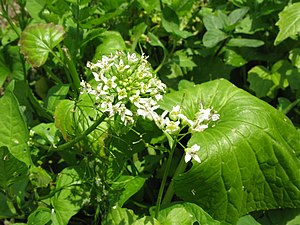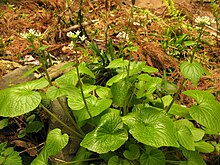Wasabi
| Wasabi | ||||||||||||
|---|---|---|---|---|---|---|---|---|---|---|---|---|

Wasabi ( Eutrema japonicum ) |
||||||||||||
| Systematics | ||||||||||||
|
||||||||||||
| Scientific name | ||||||||||||
| Eutrema japonicum | ||||||||||||
| ( Miq. ) Koidz. |
Wasabi ( Eutrema japonicum ) ( Japanese ワサビ or 山葵 , formerly 和佐比 ) and Japanese horseradish or water horseradish called, is a plant type from the family of the cabbage family (Brassicaceae). The rhizomes are used in Japanese cuisine as a hot spice . As a wild plant , the species is native to swampy terrain on the edge of running waters in Japan . It is also cultivated as a crop in other parts of the world, especially in Taiwan , Korea , Israel , Thailand and New Zealand .
description
Vegetative characteristics
Eutrema japonicum grows as a perennial herbaceous plant and reaches heights of 20 to 60 (rarely up to 75) cm. For the kitchen, the root is used, which is formed as a vertically growing, fleshy rhizome with a diameter of about 3–5 cm and a length of up to 30 cm. The plant parts are mostly smooth or sparsely hairy in the upper area. The upright to lying stems are not branched. The simple leaves are arranged in a basal rosette and distributed on the stem. The basal leaves are usually 10 to 20 (6 to 26) cm long and stalked and the 6–15 cm by 6–18 cm large leaf blade is heart-shaped to kidney-shaped with almost entire to serrated leaf margin. The central stem leaves are 1 to 5 (rarely up to 8) cm long and stalked and the leaf blade is broad-ovate to ovate-heart-shaped, 1.5 to 4 (to 6) cm long and 2 to 4 (to 6) cm wide with almost whole to toothed leaf margin.
Generative characteristics
The flowering period extends from March to May. The loose, racemose inflorescence has bracts at least below. They stand on thin, 1 to 3.5 (to 5) cm long, ascending to spreading fruit stalks. The small and hermaphrodite flowers are fourfold with double perianth . The four elongated sepals are 3 to 4 mm long and 2 to 2.5 mm wide, they are sloping. The four white petals are elongated-spatulate with a length of 6 to 8 (to 9) mm and a width of 2 to 3 mm. The six white stamens are 3.5 to 5 mm long. The elongated anthers are 0.6 to 0.8 mm long. There are nectaries at the base of the stamens . The Upper constant and uni- ovary contains six to eight ovules . The gynophore is 2 to 5 mm long, the stylus is 2 to 3 mm long with a cephalic scar.
The linear pod usually has a round cross-section, a length of 1 to 2 cm and a diameter of 1.5 to 2 mm. The valves each have an indistinct main nerve. The septum is usually fully developed. The elongated seeds are 2 to 3 mm × 1 to 1.5 mm in size. The surface of the seeds is weakly reticulated and does not become mucous or not at all when wet. The fruits ripen between May and June.
The number of chromosomes is 2n = 28.
Systematics
Synonyms for Eutrema japonicum (Miq.) Koidz. are: Cochlearia wasabi Sieb., nom. nud., Eutrema wasabi Maxim., Lunaria japonica Miq. (basionym), Wasabia japonica (Miq.) Matsum., Wasabia pungens Matsum., Wasabia wasabi (Maxim.) Makino.
etymology
The name wasabi comes from Japanese . Today the term is written in katakana or hiragana syllabary ( ワ サ ビ or わ さ び ).
The earliest known mention of the plant can be found on a wooden tablet ( Mokkan ) from the Asuka period (late 6th to early 8th century) in the phonetic spelling 委 佐 俾 . In the medicinal herbs dictionary Honzō Wamyō and the general dictionary Wamyō Ruijushō , both from the early 10th century, there is the spelling 山葵 , which was the most common up to modern times. The character 山 means “mountain” and 葵 is also used in Japanese for the hollyhock (which is not related to wasabi), so that earlier German scholars mistakenly translated the name as “mountain stockrose”. This term can still be found in older literature, but is largely no longer used today. The spelling " 山葵 " is only used in Japanese - in the Chinese languages a different spelling is used for wasabi, but 山葵 was "reimported" to China as a modern loan word. The historical spelling 和 佐 比 is also a phonetic and uses Man'yōgana .
use

Wasabi is available in Europe as a powder in jars and cans or as a paste in small tubes. Freshly imported roots can only be found in specialty shops, and now also as a plant in well-stocked nurseries. As a container plant, wasabi should ideally be placed in a cool, shady place in summer. Since it is only partially hardy, it needs a cover. Bring the pot in for the winter in the house and always keep it moderately moist. This enables regular harvest all year round. The sharpness varies, the sharpest is wasabi freshly prepared from the root. Especially in the past a piece of shark skin with its typical tiny teeth sitting in the skin was used as a grater ( Samegawa-Oroshi ); today metal graters ( Oroshigane ) are mostly used . The dry powder, which is widely used in restaurants, is also sharp, but the sharpness only develops a few minutes after the powder has been mixed with water.
Since the mustard oils are sensitive to oxidation , wasabi tubes should be closed again immediately after opening and stored in the refrigerator. Freshly grated wasabi or wasabi made from mixed powder loses its flavor after about half an hour. With the tubes, this process is slowed down by preservatives and the airtight seal. The powder must also be kept in airtight cans if it is to retain its flavor for a longer period of time.
Cultivation began in Japan during the Edo period around 1600, with Utogi (now part of Shizuoka ) on the upper reaches of the Abe being considered the place of origin.
Seiyō wasabi
A wasabi surrogate made from horseradish or a mixture of horseradish and mustard is often sold on the market, some of which contains chlorophyll , spirulina or a combination of tartrazine (E 102) (since July 21, 2010 in the EU with a warning label) and Brilliant blue FCF (E 133), colored green. A preparation contains, for example, 30.4% horseradish powder , 6% mustard flour , tapioca starch , rapeseed oil , 0.5% wasabi powder, turmeric and parsley (the rest is water).
This surrogate, called Seiyō Wasabi ( 西洋 わ さ び , "Western Wasabi") or Kona Wasabi ( 粉 わ さ び , "Powder Wasabi") in Japan , has been used since 1939 and is very popular due to the poor availability and high price of real wasabi common - whole plants cost over € 200 / kg in Europe.
Retail products such as wasabi chips and wasabi crispy peas usually contain one to two percent of the original product. After a lawsuit brought forward by the Federal Association of Consumer Organizations, the Regional Court of Munich II prohibited the food company “Kattus” from selling a product under the name “Wasabi peas” because it did not contain a single gram of wasabi. In the context of the legal dispute, the company took the position that there could be no deception, as most customers did not even know what wasabi was.
Hon wasabi
Real wasabi is available as a fresh tuber that is rubbed on a grater directly at the table, frozen, grated paste or as a freeze-dried powder that has to be mixed with water. This can also be found under the name Nama Wasabi ( 生 わ さ び , “fresh wasabi”) or Hon Wasabi ( 本 わ さ び , “real wasabi”) in order to distinguish it from Seiyō Wasabi. Powder called Hon-Wasabi Shiyo must contain at least 50% real wasabi.
In the case of fresh plants, a distinction is made according to origin and varieties (e.g. Darum or Satsuma). It either grows wild in shallow, cool and mineral-rich mountain streams or is grown in hydroponics ( 沢 わ さ び Sawa Wasabi , "Bach Wasabi"), this is the better quality or ( 丘 わ さ び Oka Wasabi , "Hill Wasabi") and ( 畑わ さ び Hata Wasabi , "field wasabi"), these are of poor quality. Japan cannot meet its own needs and therefore imports large quantities from Taiwan , the People's Republic of China and the Northwest of the USA.
Hon Wasabi differs fundamentally from Seiyō Wasabi in taste and color .
A poorer, second quality wasabi powder is also obtained from the lower petioles and uppermost parts of the rhizome.
literature
- Tai-yien Cheo, Lianli Lu, Guang Yang, Ihsan Al-Shehbaz & Vladimir Dorofeev: Brassicaceae in the Flora of China. Volume 8, 2001, p. 24; Eutrema wasabi (sieve) Maxim. (Section description)
Web links
- The Secret of Wasabi on thevschool.com, accessed April 16, 2017.
Individual evidence
- ↑ A Wasabi Growers Story - updated . In: World of Wasabi . August 10, 2014 ( wasabi.org [accessed July 29, 2018]). A Wasabi Growers Story - updated ( Memento of the original from July 29, 2018 in the Internet Archive ) Info: The archive link was inserted automatically and has not yet been checked. Please check the original and archive link according to the instructions and then remove this notice.
- ^ Ihsan A. Al-Shehbaz, Suzanne I. Warwick: A Synopsis of Eutrema (Brassicaceae). In: Harvard Papers in Botany. Volume 10, Issue 2, 2005, pp. 129-135, doi : 10.3100 / 1043-4534 (2005) 10 [129: ASOEB] 2.0.CO; 2 .
- ↑ Eutrema japonicum in the Germplasm Resources Information Network (GRIN), USDA , ARS , National Genetic Resources Program. National Germplasm Resources Laboratory, Beltsville, Maryland.
- ↑ a b わ さ び の 歴 史. Kinjirushi, accessed September 4, 2018 (Japanese).
- ↑ a b c d e Mustard powder and dye: Howling, this wasabi. In: Spiegel Online . June 11, 2012.
- ↑ Kinjirushi Kona Wasabi is, for example, undyed Seiyō Wasabi. ( Memento from January 29, 2008 in the Internet Archive ) In: kinjirushi.co.jp .
- ↑ Tom Hillenbrand : Oishikunai, or Ten Things You Didn't Want to Know About Sushi. In: netzfundbuero.de , March 2, 2012.
- ↑ Packaging information "Shisu Gourmet sushi" from Shisu Vertriebsgesellschaft, Schenefeld; Purchase date December 5, 2011.
- ^ Pacific Coast Wasabi Ltd, € 164 / kg. In: wasabia.com , quoted on June 11, 2012.
- ↑ Sushi Girl, What is REAL (and FRESH) wasabi? In: iwanttomakesushi.blogspot.de , January 9, 2010.
- ↑ wasabi (Wasabia japonica (Miq.) Matsum.). In: Gernot Katzers Gewürzseiten , February 11, 2007.





